California Insulators
Reprinted from "Crown Jewels of the Wire", May 2004, page 20
Crown Jewels presents the CALIFORNIA family this month. Included in this
issue are 65 color pictures of insulators manufactured by the California Glass
Insulator Company. Additionally, we'll present historical information about the
company, examples of their advertising (circa 1912), information about where
CALIFORNIA's were used, embossing varieties, mold styles, colors, and we will
introduce you to a few of the folks who collect Californias, or who have some
choice examples in their general collection.
The insulators are presented (generally) in numerical order according to their
CD number. McDougald's Price Guide lists as many as 17 different color shades
for certain California CD numbers, so we won't be able to picture all of the
color varieties. It would literally take hundreds and hundreds of photos to
accomplish that.
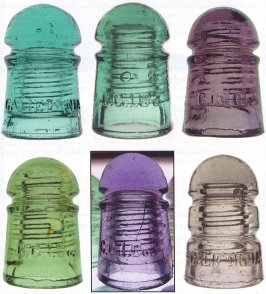
Medium Image
Large Image
(page 20)
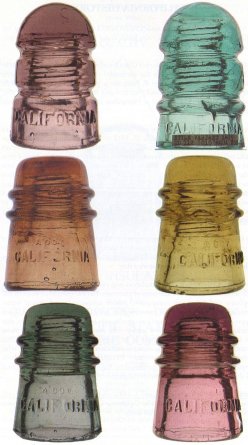
Medium Image
Large Image
(page 21)
CALIFORNIA HISTORY
The history of the company that made CALIFORNIA insulators was reported by
Ted Griffin in an article published in Crown Jewels in our September, 1982
issue. Excepts are reproduced here:
"The establishment of .the California Glass Insulator Company in Long
Beach, California came about through the successful culmination of a long search
conducted by its found, Robert P. Frist, for a good glass sand in southern
California. On Mr. Frist's second visit to Long Beach, he learned of the
discovery of high-grade silica sand at Horseshoe Bend, which proved to be just
what he needed.
Power was secured from the ten new southern California Edison plant. Wire
connections were made on March 27, 1912 to the California Glass Insulator
Company's motors. The main building housed the "tank", which the
layman would call a furnace, in which raw materials of sand, soda and hydrated
lime were melted under a heat of 2400 to 3000 degrees. Arranged around the area
of the tank were the "shops", or insulator pressing machines, of which
five were in operation in May of 1912. Each shop required a crew of five men:
one to draw the molten glass from the tank; one to cut off the exact quantity of
glass required to make an insulator; another to remove the screw core; one to
take the insulators from the molds; and the fifth to carry the insulators to the
tempering furnace.
The California Glass Insulator Company in May 1912 was employing a force of
nearly 50 men, most of whom knew nothing about glass making. Yet the workmen
were daily gaining skill and were soon producing the full capacity of the plant:
about 15,000 insulators a day.
The Pacific Coast demand for insulators was estimated at 18-million a year in
1912, representing about 7,200 tons of glass, used in the extension work of the
telephone and telegraph companies, power transmission, electrical
transportation, etc. This annual consumption west of the Rockies had been
shipped before this factory went into production by two eastern factories, one
in Indiana and the other in New Jersey. The average freight rate from those two
factories had been estimated at $8.05 per thousand insulators. This advantage in
freight rates was alone a sufficient incentive to the men who started the
California Glass Insulator Company, aside from the excellent prospects for fine
export trade promised by the opening of the Panama Canal and the resulting
stimulus to the development of trade with the Orient.
Actual production started on April 1, 1912, and shipments of their products
started a couple of days later. The California Glass Insulator Company was
incorporated with $300,000 capital stock."
(page 22)
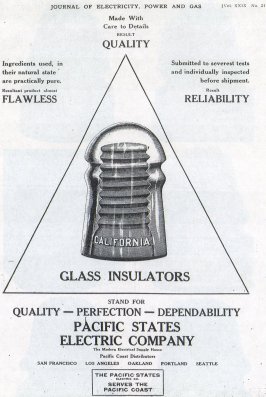
Medium Image
Large Image
Advertisement from the Journal of Electricity, Power and Gas, circa 1912. The
Journal described the CALIFORNIA insulators "as near perfect as the
most thorough inspection can accomplish." Ad provide by Colin Jung.
(page 23)
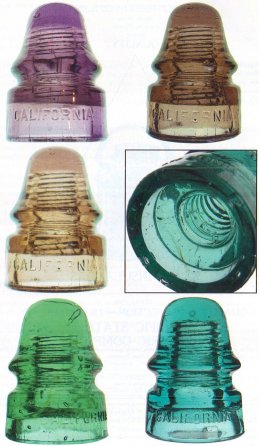
Medium Image
Large Image
(page 24)
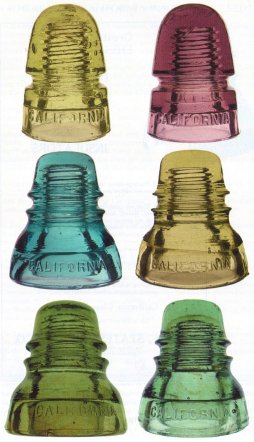
Medium Image
Large Image
(page 25)
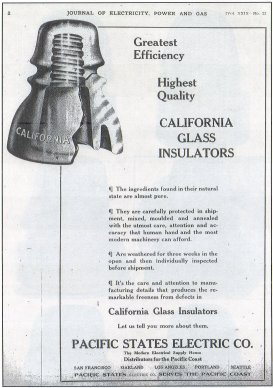
Medium Image
Large Image
Another ad from the Journal of Electricity, Power and Gas. The time period
dates from 1912 to 1914, when the company was known as the California Glass
Insulator Company. After a re-organization in 1914, the company became known as
California Glass Works. The factory was destroyed by a flood in 1916, and never
re-opened. Ad provided by Colin Jung.
(page 26)
WHERE WERE CALIFORNIA INSULATORS USED?
In his research on CALIFORNIA insulators, Ted Griffin wrote, "according
to officers of the company, insulators were to be shipped to markets as far
south as New Orleans, east to Kansas City, and north as far as Alaska and
Canada, also to Mexico, the Philippines and Japan, where there was a great
demand for glass insulators. An article in one of the Los Angeles papers of
January, 1913, stated that the company had contracts for two full years of work
and was operating day and night. The Pacific Telephone and Telegraph Company was
said to be taking (the company's) entire day output, and the night production of
the plant was reportedly going to the Chinese government.
Sometime in March of 1914, the California Glass Insulator Company closed
down. Then on April 16, 1914, following a complete reorganization of the
controlling company, it was re-opened. The plant was taken over by a new company
which was quietly formed, and was known as the California Glass Works. In
mid-May 1914, the management announced plans for improvement of an extensive and
permanent nature. New, larger furnaces were installed that nearly tripled the
then present capacity and enabled them to produce amber bottles and goods of a
similar nature.
According to management, three large contracts could be secured with the
installation of the new apparatus. They were: fifty-two boxcar loads of glass
cans for the Beech Nut Packing Company; a three-million annual insulator
contract with a San Francisco firm; and sales of beer and whisky bottles.
In an article on July 7,1914, it was stated California Glass Works had a
monthly payroll of $4,000 with 65 employees; and they planned to install
machinery to make flint ware and amber glass. The same article stated that one
carload of insulator had just been shipped to Pocatello, Idaho, and another to
Newport, Idaho, and another to San Antonio, Texas. A carload (boxcar) of
insulators at that time sold for $600 to $750, according to the class of
insulator. They had also just exported one carload to Manila, Philippines; and
were negotiating with parties in China and Honolulu. The Pacific Electric
Railway Company, the Southern Pacific Rail Road Company, the Northwestern
Pacific Railroad, the Santa Fe Railroad, the Pacific Light and Power Company,
and, the Southern California Edison Company were said to be purchasing their
entire insulator supplies from California Glass Works.
On January 18 or 19, 1916, the Long Beach harbor district was completely
flooded. According to a newspaper article, the office of the California Glass
Works was caught by swirling floods and whisked with terrific force against the
railroad tracks. The company's yard was completely inundated.
An article dated January 20, 1916 stated that $15,000 was the estimated
damage done to the buildings and premises. A stretch of ground 50 feet wide and
running the length of the street frontage of the glass company was washed out to
a depth of ten feet or more. The filling of that hole was estimated to cost
$14,000 or more. The office of the glass works was carried a distance of more
than 100 feet from its original site. A foot and a half of mud and silt was
washed on the floors of the machine shop, while the corrosion of the machinery
also added to the damage." California Glass Works ceased to exist.
(page 27)
BABY SIGNALS
CD 160 insulators are affectionately known as "baby signals" due to
their diminutive size. The insulators are 2.75 inches wide and only 3.25 inches
tall. CD 161 "signal" shaped insulators, shown below,
are three inches wide and four inches tall.
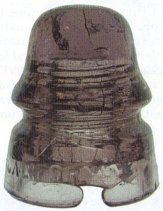
But what these babies lack in size, they have in character. An underpour of
glass into the mold turned the insulator above into a highly collectible
item.
Colors found in the baby Cal's seem to be less dramatic than in other signal
shapes, and are often pastel-like. Prices are also small by comparison, making
the babies affordable for someone interested in starting a collection of
CALIFORNIAS.
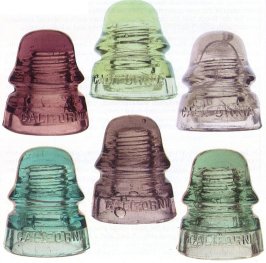
Medium Image
Large Image
(page 28)
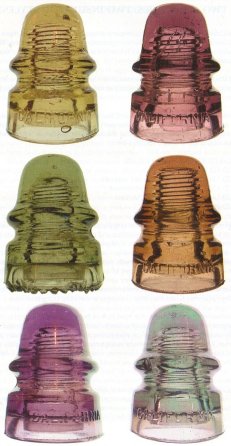
Medium Image
Large Image
(page 29)
TWO COMPANIES, TWO INSULATOR STYLES?
The California Glass Insulator Company produced insulators from April 1912 to
March 1914. After corporate reorganization, the California Glass Works produced
insulators from April 1914 until the plant was destroyed by flood in January
1916. .
Did the two companies produce insulators that were different from each other
in recognizable ways? Crown Jewels put that question to collector Colin Jung.
Here's his answer:
"Some Cal specialists have theorized that there were two distinct
periods in the manufacturing history of this company that are reflected in the
glass insulators. These collectors believe that the following insulators were
made by California Glass Works from 1914-1916:
- CALIFORNIA embossed CD 102
- CD 112 keg variant.
- CD 134 (think of it as a
CD 161 variant)
- CD 152 "taper top" hoopskirt variant
- CD 166
straight sides signal variant
- CD 260 pinch ear helmet
California Glass works was a new company, reorganized under new management to
improve the business practices and manufacturing quality of its predecessor,
California Glass Insulator Company (C.G.I.CO.). The group of insulators described
above are noticeable slimmer in one or all of the following areas compared to
their counterparts: dome, skirt and base. Slimmer insulators would have saved
on the cost of raw materials and reduced shipping costs due to lighter weights.
They are generally of higher quality; that is, fewer stress fractures,
underpours and overpours that was very characteristic of the California Glass
Insulator Company's manufacturing problems.
The most telling evidence is the total lack of purple-colored examples in
this group of insulators. The range of colors is limited to shades of green and
blue. This coincides with the cut-off of manganese shipments from Germany at the
start of World War I. Manganese was important in the early 1900's glass
manufacturing to decolorize glass. However, when exposed to the ultraviolet
rays of the sun, manganese treated glass would turn purple."
Editor's note: The "variants" listed by Colin are all relatively
scarce to find. In fact, the CALIFORNIA insulator that was most difficult of all
to find a picture of was the CD 112 variant. It is shown in the upper right
corner of page 21. Note the extra ridge of glass below the bottom wire groove,
as compared to the amethyst CD 112 shown to the left. This may be the
"sleeper" of the CALIFORNIA family, as very few specialists seem to have
this insulator.
(page 30)
CALIFORNIA COLORS
This issue of Crown Jewels magazine dramatically demonstrates that CALIFORNIA
embossed insulators come in a rainbow of colors. However, just because a lot of
brilliantly colored insulators are shown here, don't think that's the norm. It
most certainly is not. By far and away, the most common color of glass in
CALIFORNIA insulators is sage green. So many sage greens exist that they can be
purchased for very little even today at insulator shows. $1.00 will get you a CD
161 in sage. $5 for a CD 133. Maybe $10 for a CD 145. Other common colors
include smokey amethyst, off clear and medium amethyst.
The most controversial color is "yellow". Some collectors believe
many CALIFORNIA insulators were of a yellow coloration when manufactured, and
turned to off clear and amethyst shades when exposed to the ultraviolet rays of
the sun. The theory is supported by the fact that many of the yellow insulators
have been found in locations where they did not received solar exposure. Yellows
have been found indoors in sawmills, manufacturing plants, and elevator shafts;
outdoors in shaded alleyways; and have been dug from dumps and being buried
along pole lines.
However, heat will change an amethyst CALIFORNIA to a yellow shade. Before spending a lot of
money on a yellow CALIFORNIA, inspect the
insulator for indications of having been exposed to high temperatures: such
as slumping of the overall shape, warping of the embossing, or extensive
fractures. Some yellow CALIFORNIAS, usually fractured, have been found in the
wake of forest fires. But buyers should be aware that
inexpensive amethyst CALIFORNIAS, can be altered into expensive-appearing yellows by heat.
Conversely, be aware of the possibility
that your expensive yellow insulator could turn to an inexpensive amethyst if
exposed to the sun in a window sill.
"Peach'" is a variety of "yellow" found in the CALIFORNIA list of colors.
Take a look at the CD 190/191 two piece CALIFORNIA shown on page 33. The bottom of these two piece
units is often peach in color, while the tops are often a darker
amethyst. Was this the result of the base being protected from solar radiation
by the top? Or were the base pieces manufactured from a different batch of
glass? Another scarce color is referred to by collectors as "copper".
Examples of "coppers" have been known since the early days of the
hobby.
"Two Tone" is another "hot" color for CALIFORNIAS. The
glass used by the California Glass Insulator Company was obviously, and
frequently, poorly mixed. The result is a great variety of two tone insulators.
Some are quite dramatic, as the CD 161 shown on the lower right corner of page
29, or the CD 162 at the top right of page 32. However, even minor two tone
variations are prized by collectors, as long that the color separation is
distinct.
(page 31)
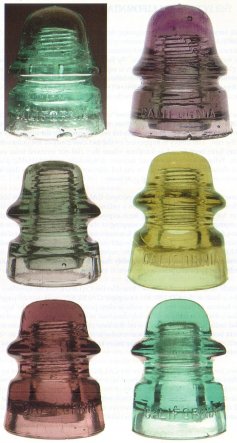
Medium Image
Large Image
(page 32)
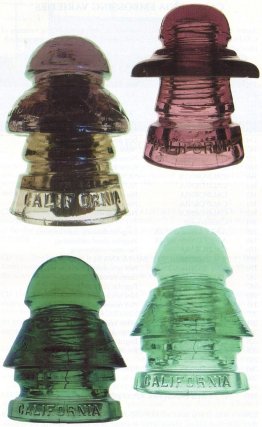
Medium Image
Large Image
(page 33)
CALIFORNIA EMBOSSING VARIETIES
Aware that collector Colin Jung is actively studying embossing varieties of
CALIFORNIA insulators, Crown Jewels asked Colin for his latest research. Here's
Colin's list of embossing varieties:
|
CD
|
EMBOSSING
|
EMBOSSING VARIATIONS
|
|
102
|
C.G.I.Co.
|
None known
|
|
102
|
CALIFORNIA
|
None known
|
|
112
|
CALIFORNIA
|
None known
|
|
121
|
A007 / CALIFORNIA
|
"00" same size as "A" and
"7"
|
|
121
|
A007 / CALIFORNIA
|
"00" smaller than" A"
and "7"
|
|
133
|
CALIFORNIA
|
None known
|
|
134
|
CALIFORNIA
|
Not researched, too
few known
|
|
145
|
CALIFORNIA
|
None known
|
|
152
|
CALIFORNIA
|
None known
|
|
160
|
CALIFORNIA
|
None known
|
|
161
|
CALIFORNIA
|
"A" on dome
|
161
|
CALIFORNIA
|
"A" on
dome, sharp drip points
|
161
|
CALIFORNIA
|
No embossing on dome
|
161
|
CALIFORNIA
|
No
embossing on dome, sharp drips
|
162
|
CALIFORNIA
|
None known
|
164
|
Unembossed
|
|
166
|
A011
/ CALIFORNIA
|
Large embossing (one known)
|
166
|
A011 / CALIFORNIA
|
Regular sized
embossing
|
166
|
CALIFORNIA
|
No other embossing
|
178
|
CALIFORNIA (f) 303 / SANTA ANA
(r)
|
|
178
|
303 / SANTA ANA
|
Not researched, too few known
|
187
|
CALIFORNIA
|
Large
embossing
|
187
|
CALIFORNIA
|
Regular sized embossing
|
190
|
A021 / CALIFORNIA
|
Not
researched, too few known
|
191
|
A021 / CALIFORNIA
|
Not researched, too few known
|
200
|
CALIFORNIA
|
None known
|
201
|
CALIFORNIA
|
None known
|
208
|
CALIFORNIA
|
Large
embossing
|
208
|
CALIFORNIA
|
Regular sized embossing
|
208
|
CALIFORNIA
|
Regular
embossing with small "OR"
|
210
|
Unembossed
|
|
260
|
CALIFORNIA
|
None known
|
260
|
CALIFORNIA
|
"pinch ear" style, no embossing varieties known
|
1130
|
10 /
CALIFORNIA PAT. APL'D FOR
|
|
1131
|
15 / CALIFORNIA PAT. APL'D FOR
|
|
Editor's note: If you have a CALIFORNIA insulator with embossing different
than described above, please write or email us at Crown Jewels. We'd especially
like to hear about anyone owning a CD 112 embossed C.G.I.CO.
(page 34)
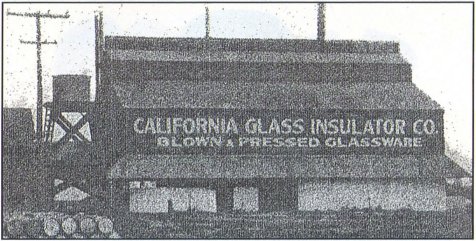
CALIFORNIA MOLD VARIETIES
Under this headline we'll talk about variations in the shapes of insulators
of a specific CD. Collector Brent Burger wrote a series of articles about
CALIFORNIA insulators for Crown Jewels in 1980 - 1981. Here's a summary of some
of his observations:
CD 102: For ponies embossed both CALIFORNIA and C.G.I.CO., Brent described two
dome styles... one a bit pointed with a small "button" at the top of
the dome, and one more rounded. The first style is 3.5 inches tall; the other 3-3/8ths.
CD 112: The keg variant is described at the bottom of page 30. Even in 1980
Brent commented on how tough the variant is to locate, noting "they rarely
hit the sales table", and lamenting that he didn't yet own one.
CD 134: Brent wrote, "The CD 134 and CD 161 are identical in outer
design shape, the only difference being that someone forgot to put inner skirts
in the 134's before they were shipped from the factory." See page 24 of
this issue for an underside view. CD 134's are scarce. An ICON survey a couple
of years ago estimated that fewer than 50 examples are known.
CD 152: Brent coined the term "taper top" to describe a scarce
variant of the CD 152 "hoop skirt". The dome seems smaller and the
sides slope more noticeably that in most 152's. See the picture on page 25
(center row, left insulator ).
CD 260: Collectors called the narrow cable groove variety "pinch
ears". See page 40, bottom row, for a pair of "pinch ears" in two
distinctly different shades of green-aqua. Brent wrote in 1981 that all of the
"pinch ears" known at that time came from a Shell Oil Company refinery
in Richmond, California.
(page 35)
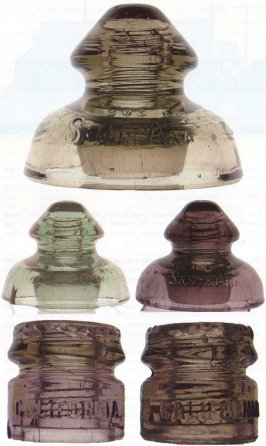
Medium Image
Large Image
(page 36)
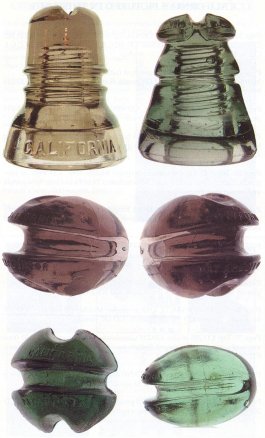
Medium Image
Large Image
(page 37)
CALIFORNIA'S PICTURED IN THIS ISSUE
Page 20: Top row: CD 102 CALIFORNIA; CD 102 C.G.I.CO. tall dome; CD 102 C.G.I.CO.
round dome. Bottom row: CD 102 C.G.I.CO. in green, CD 102 C.G.I.CO. in
violet (unlisted), CD 112 in smokey.
Page 21: Top row: CD 112 dark amethyst (unlisted), CD 112 variant; Middle
row: CD 121 copper, CD 121 peach; Bottom row: CD 121 sage; CD 121 burgundy.
Page 24: Top row: CD 133 purple, CD 133 dark rose; Middle row: CD 133 peach,
CD 134 bottom view; Bottom row: CD 134 green aqua, 134 in aqua.
Page 25: Top row: CD 145 yellow, 145 burgundy; Middle row: CD 152 taper top,
152 yellow; Bottom row: 152 dark green (due to heavy amber swirls), 152 greenish
(due to amber swirls).
Page 28: Top: CD 160 dramatic underpour; Middle row: CD 160's in burgundy,
light yellow green, gray; Bottom row: CD 160's in blue, light purple and smoky
sage green.
Page 29: Top: CD 161 yellow, CD 161 burgundy; Middle row: CD 161 with drip
points; CD 161 copper; Bottom row: CD 161 dark purple; CD 161 two tone purple
& sage.
Page 32: Top: CD 162 underlit to show heavy milk, CD 162 two tone purple
& sage; Middle row: CD 164 unembossed, CD 166 yellow; Bottom row: CD 166
burgundy, CD 166 scarce variant.
Page 33: Top: CD 190/191 (among the rarest of CALIFORNIA's), CD 200 burgundy;
Bottom: CD 201 dark green aqua, CD 201 green aqua.
Page 36: Top: CD 178 SANTA ANA in smoke; Middle: CD 178 sage, CD 178
burgundy; Bottom: CD 187 light purple, CD 187 smoke.
Page 37: Top: CD 208 smoke, CD 210 unembossed; Middle row: CD 1131 (two views
of same strain insulator); Bottom row: CD 1131 sage green (end view), CD 1130
sage green (side view).
Page 40: Top: CD 260 light purple, CD 260 dark purple; Bottom: CD 260 pinch
ear in 'green aqua, CD 260 pinch ear in aqua.
Page 41: Top: CD 260 yellow, CD 260 peach; Bottom: CD 260 sage green, CD 260
green (rare color with only a few reported)
(page 38)
CONTRIBUTORS TO THE CALIFORNIA ARTICLE
Here are a few of the people who contributed pictures or information for this
month's feature article on CALIFORNIA insulators:
Crown Jewels thanks everyone for their help:
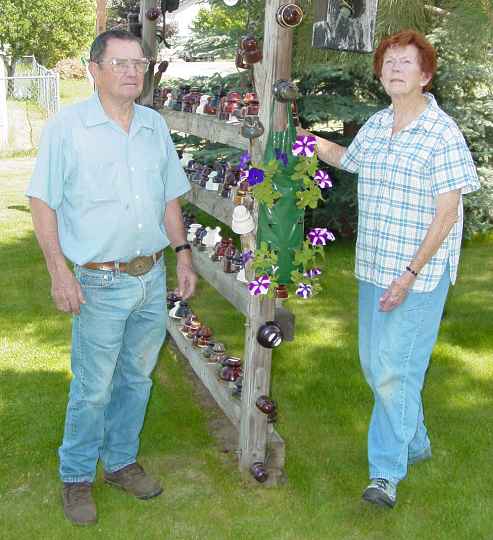
Jeanne & Joe Bridges (shown with their yard display).
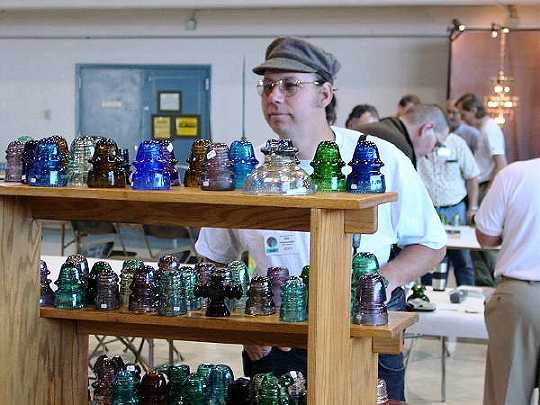
Bill Ostrander
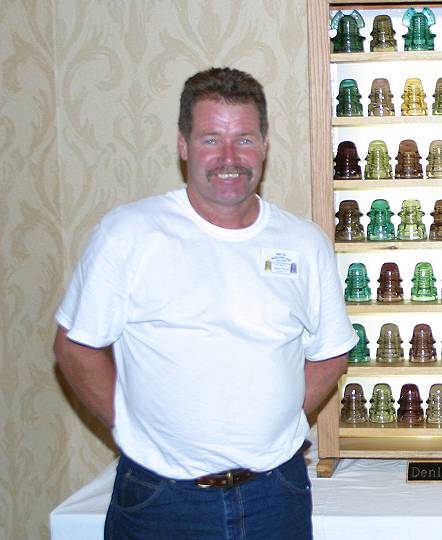
Denley Bryson
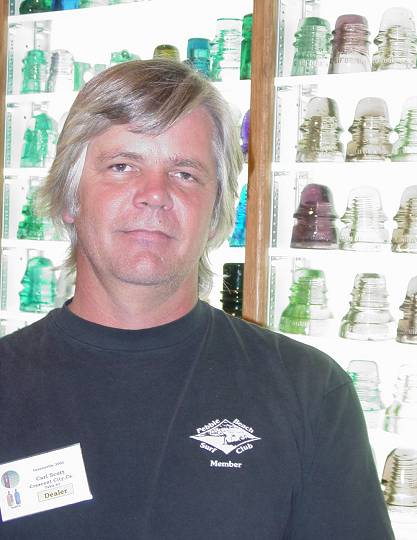
Carl Scott
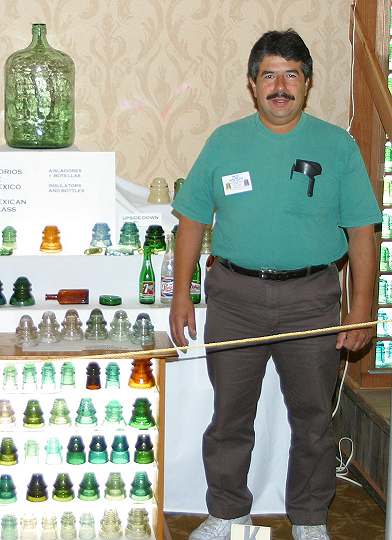
Dave
Hall
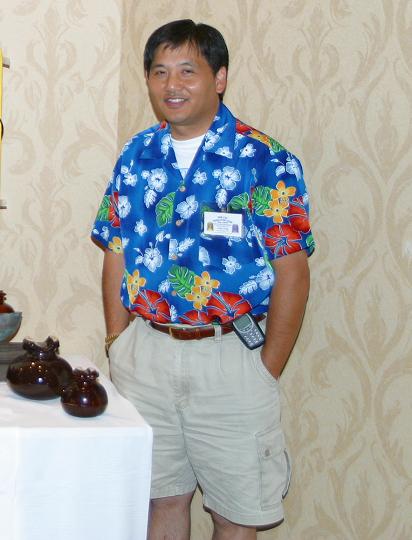
Colin Jung
We also showed insulators owned by Glenn
Adkins, Tim Wood & Janet Bond.
Photographs were taken by Colin Jung, Bill Ostrander, Carol McDougald, Carl
Scott, Kevin Jacobson, & Howard Banks
References: Insulators Price Guide, by John & Carol McDougald, 2003.
Thanks to Tommy Bolack, whose donations pay for the color printing.
(page 39)
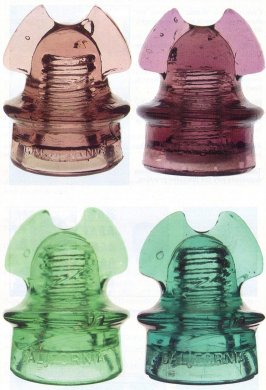
Medium Image
Large Image
(page 40)
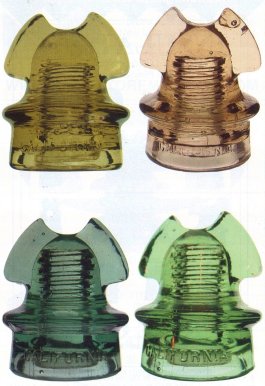
Medium Image
Large Image
(page 41)
| 